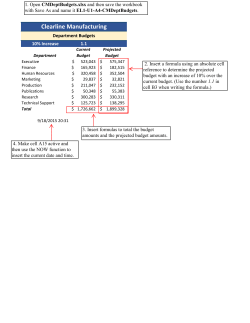
Global Hemodynamic Monitoring System Market, 2015 to 2021
Global Hemodynamic Monitoring System Market, 2015 to 2021 Persistence Market Research Global Hemodynamic Monitoring Systems Market Poised to Account for US$ 508.4 Mn by the End of 2021: Persistence Market Research Persistence Market Research 1 Global Hemodynamic Monitoring System Market, 2015 to 2021 Persistence Market Research Released New Market Report According to a new market report published by Persistence Market Research “Global Market Study on Hemodynamic Monitoring System: Growing Demand for Critical Congenital Heart Disease Screening to Drive the Market by 2021 ”, projected the hemodynamic monitoring systems market to expand at a healthy CAGR of 6.5% during the forecast period. The report offered trends driving the market and delivered analysis and insights on the potential of the hemodynamic monitoring systems market in specific regions. In terms of revenue, the hemodynamic monitoring systems market was valued at US$ 328.7 Mn in 2014 and is projected to reach US$ 508.4 Mn by 2021. Factors driving market growth include government and private sector initiatives to reduce healthcare costs, rising prevalence of lifestyle diseases, growing the geriatric patient population, increasing the incidence of respiratory disorders and growing demand for the screening of critical congenital heart disease (CCHD). Request Sample Report: http://www.persistencemarketresearch.com/samples/4396 In terms of region, North America dominated the hemodynamic monitoring systems market with over 30% share in terms of value in 2014 but is expected to lose its market share to APAC by 2021. Europe accounted for over 20% of the total hemodynamic monitoring systems market share in 2014 and will maintain its dominance through 2021. Among the regions, APAC is projected to register the highest CAGR over 2015–2021 due to low-cost product offerings by manufacturers in the region. As of 2014, APAC was the third-highest contributor to the overall hemodynamic monitoring systems market, accounting for over 18% market share. By the end of 2021, it is projected to gain 330 BPS. On the basis of device type, the market has been segmented into pulse contour, oesophageal Doppler, volume clamp, hemodynamic monitoring sensors and pulmonary artery catheters. The pulmonary artery catheters segment had a dominant share in the global hemodynamic monitoring systems market in 2014, while the volume clamp segment accounted for over 20% share. Persistence Market Research 2 Global Hemodynamic Monitoring System Market, 2015 to 2021 Global hemodynamic monitoring systems market is further segmented on the basis of end use into hospitals, clinics, ambulatory surgery centres, home care settings and independent catheterisation laboratories. Revenue contribution of the hospitals segment was over 40% in 2014 and is projected to increase to over 42% by 2021, registering a significant CAGR of 7.3%. Home care settings segment is anticipated to record highest CAGR during the forecast period as hemodynamic monitoring systems are being adopted increasingly in home care settings. By application type, the hemodynamic monitoring systems market is segmented into invasive hemodynamic monitoring, noninvasive hemodynamic monitoring and minimally invasive hemodynamic monitoring segments. Among the three segments, minimally invasive hemodynamic monitoring segment is expected to register the highest CAGR of 8.0% over 2015-2021. The invasive hemodynamic monitoring segment accounted for over 30% market share in 2014 but is projected to lose its share to the other two segments by the end of the forecast period. View Detail Report With TOC: http://www.persistencemarketresearch.com/marketresearch/hemodynamic-monitoring-system-market.asp Key players in the global hemodynamic monitoring systems market include Edwards Lifesciences Corporation, ICU Medical, Inc., Teleflex Incorporated, LiDCO Group Plc and PULSION Medical Systems SE. Global players focus on research and development initiatives for introducing innovative products to attain sustainable advantages over their competitors. In addition, they also focus on expanding their regional presence through mergers and acquisitions. In developed regions, hemodynamic monitoring systems manufacturers prefer selling their products directly to the consumer. By contrast, most vendors in countries such as China have tie-ups with suppliers to enhance their customer reach. Globally, medical equipment manufacturers in China account for over 50% market share for exporting noninvasive devices. Request Customized TOC: http://www.persistencemarketresearch.com/toc/4396 Persistence Market Research 3 Global Hemodynamic Monitoring System Market, 2015 to 2021 Market History: The hemodynamic monitoring system is primarily used for clinical inspection of cardiovascular health, longevity and quality of life of patients undergoing and recovering from cardiac surgery. These parameters are measured using photometric, electrical, pressure transducing equipment and invasive and noninvasive devices. The hemodynamic monitoring system also involves a use of various intravascular catheters. Some factors boosting the demand for hemodynamic monitoring systems are rising prevalence of lifestyle diseases, increasing the incidence of respiratory disorders, growing demand for the screening of critical congenital heart disease (CCHD), government and private sector initiatives to reduce healthcare costs as well as growing geriatric patient population. CCHD, one of the seven most severe congenital heart defects, can be life threatening to neonates. Asthma and chronic obstructive pulmonary diseases are among the most common respiratory diseases. More than nine-tenths of deaths in low- and middle-income countries occur due to chronic obstructive pulmonary diseases. The global hemodynamic monitoring systems market is anticipated to register significant CAGR during the forecast period. PMR projects the global hemodynamic monitoring systems market to account for US$ 508.4 Mn by the end of 2021. Hemodynamic monitoring systems market is expected to gain traction in developing regions such as APAC and Latin America. The global hemodynamic monitoring systems market has been segmented into devices based on technologies and methods such as pulse contour, oesophageal doppler, volume clamp, hemodynamic monitoring sensors and pulmonary artery catheters. The pulmonary artery catheters segment is estimated to dominate the global hemodynamic monitoring systems market with 35.0% share by 2015 end, followed by volume clamp segment. Increasing concerns regarding use of invasive techniques, particularly pulmonary artery catheter for measuring cardiac output, have paved way for alternative methods for measuring hemodynamic variables. Cardiac surgeons are increasingly seeking less invasive Persistence Market Research 4 Global Hemodynamic Monitoring System Market, 2015 to 2021 approaches to aortic or mitral valve surgery. Key players are offering various systems that enable minimal incision valve surgery. By application, the global hemodynamic monitoring systems market has been segmented into invasive hemodynamic monitoring, non-invasive hemodynamic monitoring and minimally invasive hemodynamic monitoring. The invasive hemodynamic monitoring segment is projected to lose its dominance throughout the forecast period. Noninvasive hemodynamic monitoring application segment is projected to gain BPS during the forecast period. Among the three application segments, minimally invasive hemodynamic monitoring segment is anticipated to record the highest CAGR by the end of the forecast period. By end-use, the hemodynamic monitoring systems market is segmented into home care settings, ambulatory surgery centres, hospitals, clinics and independent catheterisation laboratories. Hospitals segment is projected to exhibit above-average growth during the forecast period. The global hemodynamic monitoring systems market has been segmented into five regions: North America, Latin America, Europe, APAC and Middle East & Africa. North America region was the largest market in terms of revenue contribution, accounting for 30.5% share of the overall hemodynamic monitoring systems market in 2014. This is attributed to the increasing number of cancer and cardiovascular patients, especially in the U.S. Europe region is projected to lose 40 BPS during the forecast period. Among the five regions, APAC region is projected to expand at the highest CAGR during the forecast period. Some key players included in the report are Edwards Lifesciences Corporation, ICU Medical, Inc., Teleflex Incorporated, LiDCO Group Plc and PULSION Medical Systems SE. Global players are investing on R&D to introduce innovative products in order to gain competitive edge. Additionally, they are also focusing on regional expansion through mergers and acquisitions. In developed regions, hemodynamic monitoring systems manufacturers prefer selling their products directly to consumer. By contrast, most vendors in countries such as China have tie-ups with suppliers to enhance their customer reach. Globally, medical equipment Persistence Market Research 5 Global Hemodynamic Monitoring System Market, 2015 to 2021 manufacturers in China account for over 50% market share for exporting noninvasive devices. About Us: Persistence Market Research (PMR) is a full-service market intelligence firm specializing in syndicated research, custom research, and consulting services. PMR boasts market research expertise across the Healthcare, Chemicals and Materials, Technology and Media, Energy and Mining, Food and Beverages, Semiconductor and Electronics, Consumer Goods, and Shipping and Transportation industries. The company draws from its multi-disciplinary capabilities and high-pedigree team of analysts to share data that precisely corresponds to clients’ business needs. Contact Us: Persistence Market Research 305 Broadway 7th Floor, New York City, NY 10007, United States, USA - Canada Toll Free: 800-961-0353 Email: sales@persistencemarketresearch.com Web: http://www.persistencemarketresearch.com Persistence Market Research 6
© Copyright 2025









